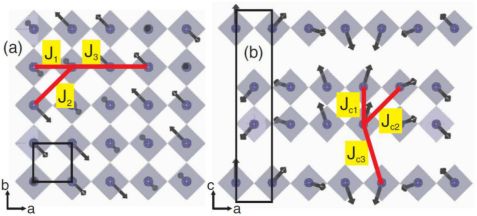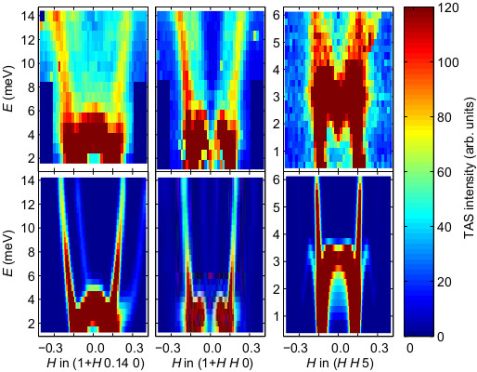MLZ ist eine Kooperation aus:
 > Technische Universität München
> Technische Universität München > Helmholtz-Zentrum Hereon
> Helmholtz-Zentrum Hereon
 > Forschungszentrum Jülich
> Forschungszentrum Jülich
MLZ ist Mitglied in:
 > LENS
> LENS > ERF-AISBL
> ERF-AISBL
MLZ in den sozialen Medien:

MLZ
Lichtenbergstr.1
85748 Garching
Competing Ferromagnetic and Antiferromagnetic Interactions in the 2D Spiral Magnet Sr3Fe2O7
J.-H. Kim,1 Anil Jain,1,2 M. Reehuis,3 G. Khaliullin,1 D. C. Peets,1 C. Ulrich,1,4,5 J. T. Park,6 E. Faulhaber,6 A. Hoser,3 H. C. Walker,7 D. T. Adroja,7,8 A. C. Walters,1 D. S. Inosov,1,9 A. Maljuk,1,10 and B. Keimer1
1Max-Planck-Institut für Festkörperforschung, D-70569 Stuttgart, Germany
2Solid State Physics Division, Bhabha Atomic Research Centre, Mumbai 400085, India
3Helmholtz-Zentrum Berlin für Materialien und Energie, D-14109 Berlin, Germany
4School of Physics, University of New South Wales, Sydney, New South Wales 2052, Australia
5Australian Nuclear Science and Technology Organisation, Lucas Heights, New South Wales 2234, Australia
6Heinz Maier-Leibnitz Zentrum (MLZ), D-85748 Garching, Germany
7ISIS Facility, STFC, Rutherford Appleton Laboratory, Chilton, Didcot, Oxfordshire OX11-0QX, United Kingdom
8Physics Department, University of Johannesburg, P.O. Box 524, Auckland Park 2006, South Africa
9Institut für Festkörperphysik, TU Dresden, D-01069 Dresden, Germany
10Leibniz Institut für Festkörper-und Werkstoffforschung, D-01171 Dresden, Germany
We use inelastic neutron scattering to investigate the spin dynamics of the stoichiometric bilayer perovskite Sr3Fe2O7, which undergoes a temperature driven metal-insulator transition (MIT) and a transition to helical magnetic order. We show that the measured magnetic excitation spectra can be well described within the framework of an effective Hamiltonian with up to third-nearest-neighbor exchange interactions. The estimated strengths of ferromagnetic double-exchange and antiferromagnetic superexchange interactions are comparable, indicating that competition between such antagonistic exchange interactions stabilizes helical magnetism near the MIT.
Magnetic dynamics in the proximity of the metal-insulator transition
Despite recent progress in the theoretical description of metal-insulator transitions (MITs), the understanding of magnetic correlations near MITs remains challenging. Following dynamical mean-field theory, it is generally believed that in transition-metal oxides (TMO) localized spins in insulating Hubbard-like bands interact via antiferromagnetic superexchange interactions, whereas ferromagnetic double-exchange interactions are driven by itinerant electrons in their metallic bands [1]. According to a long-standing theoretical prediction [2], the competition between antiferromagnetic superexchange interactions and ferromagnetic double-exchange interactions can lead to noncollinear magnetic structures in the vicinity of MITs. However, alternative interpretations have also been proposed. Specifically, the ferromagnetic double-exchange interaction alone can generate a spiral magnetic phase in TMOs with metal ions in high oxidation states [3]. The difference between the two scenarios is the magnitude and spatial range of the exchange interactions, which can be tested by measuring spin-wave dispersions by means of inelastic neutron scattering (INS). To the best of our knowledge, however, INS measurements on stoichiometric model compounds have thus far not been carried out, mainly due to difficulties in obtaining large enough single crystals of sufficient quality.
We have used the clean and fully oxygenated stoichiometric compound Sr3Fe2O7 (TN = 115 K, TMIT = 340 K) to study the magnetic structure and dynamics by neutron scattering.
Spiral magnetic order
First, single crystal and powder neutron diffraction measurements were carried out on the E5 and E6 diffractometers at BER-II (Helmholtz-Zentrum Berlin, Germany), respectively, to determine its magnetic structure. The magnetic structure of Sr3Fe2O7 obtained, based on refinement of diffraction data, is an elliptical helix with a c component significantly smaller than its ab components. As illustrated in Fig. 1, all spins lie in a plane perpendicular to the [110] direction. Along the c axis, the spins of the iron atoms at (0 0 ±z) are antiparallel with those at (0.5 0.5 0.5 ±z) [see Fig. 1(a)], which yields the component of the propagation vector kz = 1.
Magnetic excitation spectra and calculations
To study the magnetic dynamics in Sr3Fe2O7, we performed a series of INS measurements at the three-axis spectrometers PANDA (cold neutrons) and PUMA (thermal neutrons) on a single crystal with diameter 5 mm and length 50 mm. During the INS experiments both at PANDA and PUMA, we used a double-focusing PG(002) monochromator and analyzer to maximize the neutron flux at the sample position while preserving reasonable instrumental resolution. To eliminate higher-order neutron contamination, a Be filter before the analyzer was used at PANDA and a sapphire filter and two PG filters were inserted before the monochromator and after the analyzer at PUMA, respectively. The final neutron wave vector was fixed to kf = 1.57 Å-1 on PANDA and to 2.662 Å-1 on PUMA.
The upper panels of Figure 2 show the scattered neutron intensity distribution in momentum and energy below TN (T = 7 K). The neutron scattering dataset in the first two upper panels was obtained on PUMA, measuring along the [H00] (left) and [HH0] (middle) directions up to 14 meV. While sharply dispersive spin-wave branches are clearly seen, the features close to the zone center remain ambiguous. To further resolve the low-energy magnetic excitations, we have mapped out the spin-wave excitations up to 6 meV along [HH5] on PANDA with better energy and momentum resolution (Fig. 2 upper right), where no significant spin anisotropy gap was seen.
To fit the observed spin-wave dispersion and intensities, we carried out standard linear spin-wave calculations [4], using a minimal set of input parameters in the following equation:
where Jij represents the Heisenberg coupling between the i_-th and _j_-th spins S, Δ > 0 is the easy (110) plane anisotropy parameter, and Sα refers to the spin component along the [110] axis. The lower panels in Fig. 2 represent the results of calculations with the following parameters: _J1 = – 7.2 meV, J2 = 1.05 meV, J3 = 2.1 meV, Jc1 = – 5.1 meV, Jc2 < 0.01 meV, Jc3 = 0.01 meV and Δ = 0.06 meV. Here, positive values of J represent antiferromagnetic interactions. The calculations are in excellent agreement with the measured spin excitation spectra (Fig. 2).
Confirmation of long-standing theory
The competition between ferromagnetic double-exchange interactions and antiferromagnetic superexchange interactions is controlled by the degree of itinerary or localization of the conduction electrons, and a strong modification in electron correlations near the MIT region can generate a fine balance between them. Based on this scenario, the sign and relative strength of exchange interactions extracted from the magnon dispersion of Sr3Fe2O7 with a quasi-two-dimensional spiral state near a MIT are in line with theoretical estimations [1]. Thus, our spin excitation measurements, together with calculations, provide a quantitative confirmation of a decades-old theoretical prediction [2] and a firm experimental basis for further experimental and theoretical work on TMOs near MITs.
References:
[1] G. Khaliullin, Prog. Theor. Phys. Suppl. 160, 155 (2005).
[2] P.-G. de Gennes, Phys. Rev. 118, 141 (1960).
[3] M. Mostovoy, Phys. Rev. Lett. 94, 137205 (2005);
Z. Li et al., Phys. Rev. B 85, 134419 (2012).
[4] G. Khaliullin and R. Kilian, Phys. Rev. B 61, 3494 (2000).
MLZ ist eine Kooperation aus:
 > Technische Universität München
> Technische Universität München > Helmholtz-Zentrum Hereon
> Helmholtz-Zentrum Hereon
 > Forschungszentrum Jülich
> Forschungszentrum Jülich
MLZ ist Mitglied in:
 > LENS
> LENS > ERF-AISBL
> ERF-AISBL
MLZ in den sozialen Medien:





